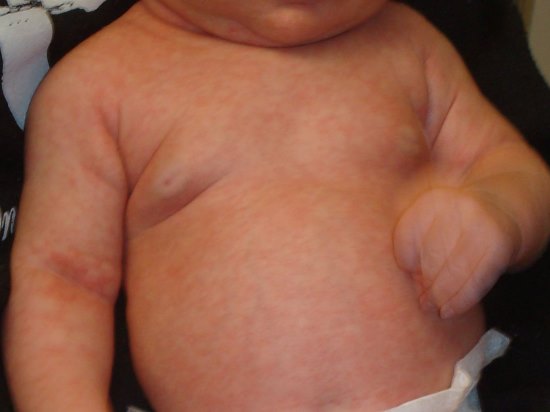About roseola infantum
Roseola infantum is caused by a type of herpes virus called human herpesvirus 6. This virus spreads when children touch or breathe in droplets from an infected child’s cough or sneeze. It can also spread through direct contact among children.
Roseola is very common in young children. Nearly all children have had roseola by 2 years of age.
Older children and adults can also get roseola, but this is rare.
Symptoms of roseola infantum
Roseola might start with a runny nose, cough and sore throat.
After this, children might get a sudden fever. The fever can be higher than 40°C and last 3-4 days. Children might also have swollen lymph nodes in the neck.
After the fever disappears, a rash might develop. The rash consists of slightly raised spots on the chest, tummy and back. The rash might look brown, grey or purple on dark skin or pink on light skin. The rash rarely lasts more than 24 hours. Some children have no rash at all.
Most children with roseola recover fully within a week.

Roseola is most contagious before the rash appears and when the fever is at its highest.
Medical help: when to get it for children with roseola infantum
You can usually manage roseola at home.
But you should go to your GP if you’re worried about your child or your child:
- can’t or won’t drink fluids
- has a severe headache
- has extremely sore muscles
- has trouble breathing
- has a febrile seizure.
Take your child to your local hospital emergency department or call 000 for an ambulance straight away if your child is drowsy, weak or confused.
You know your child best. If your child seems unwell, seek medical attention.
If your child stops breathing following a febrile seizure, call an ambulance on 000 immediately and start CPR for babies or CPR for children over one year. Also phone 000 and ask for an ambulance if the febrile seizure lasts longer than 5 minutes.
Treatment for roseola infantum
Roseola usually improves on its own, but there are things you can do to ease your child’s symptoms:
- Give your child paracetamol or ibuprofen in recommended doses if your child has a fever and is uncomfortable.
- Encourage your child to drink plenty of water and get plenty of rest.
Don’t give aspirin to children under 12 years unless it’s prescribed by a doctor. Aspirin can increase the risk of Reye’s syndrome, a rare but potentially deadly condition. If you’re giving your child any over-the-counter medicines, check with your pharmacist or doctor to make sure these have no aspirin.
Prevention of roseola infantum
Good hand-washing is the best way to stop common childhood illnesses like roseola from spreading. It’s also important to cough or sneeze into a tissue or your elbow rather than into your hands and to teach your child to do this too.
Children with roseola should avoid contact with other young children and people who have weakened immune systems.